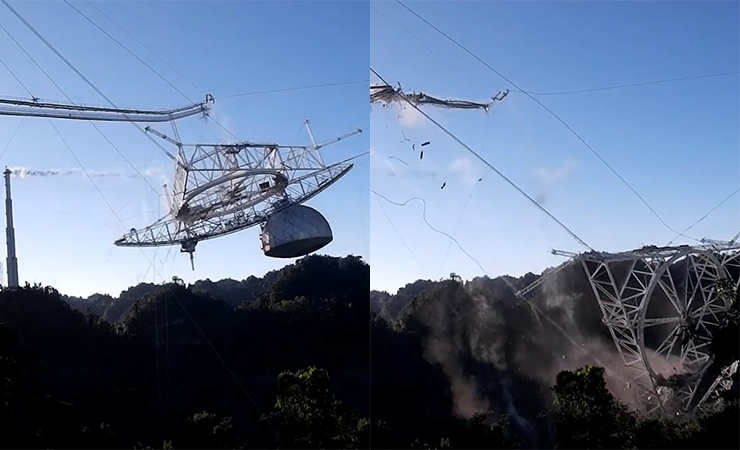
Stills from footage of the Arecibo telescope platform collapse.
(Image credit – Arecibo Observatory)

Stills from footage of the Arecibo telescope platform collapse.
(Image credit – Arecibo Observatory)
Suffering a cascading series of cable failures, the 900 ton instrument platform of the Arecibo radio telescope in Puerto Rico collapsed
NSF has indicated that any decision for it to request funding to rebuild Arecibo will be routed through its major research facility construction process, which weighs input from the scientific community and other stakeholders. In the near term, the agency has committed to continue supporting STEM outreach efforts at the site as well as certain research assets that are part of the broader Arecibo observatory complex.
Meanwhile, proponents of the telescope have quickly mobilized a campaign for constructing a replacement and have begun reaching out to Congress to build support.
A multi-purpose telescope with unique capabilities, Arecibo supported a broad portfolio of astronomical and upper-atmosphere research and assisted NASA in characterizing near-Earth asteroids using its planetary radar
A petition advocating to rebuild the telescope was launched the day after the collapse and has since garnered more than 58,000 signatures
In parallel, a group of astronomers connected to the facility has begun sketching out concepts for a new and improved telescope. Ray Lugo, director of the Florida Space Institute at the University of Central Florida, which manages Arecibo, told
Asked for more details, Lugo told FYI that $400 million is a rough estimate and “represents a budget that would enable the construction of a facility that surpasses all existing facilities in capability.” He indicated a key question facing the design group is whether the reflector dish would be reconstructed in its previous form or built to be “larger and possibly ‘point able.’” He suggested the group is unlikely to propose another suspended instrument platform if the science goals can be achieved with another configuration, since the platform “will always be a ‘risk.’”
A handful of legislators have publicly weighed in on NSF’s decision to decommission the telescope.
On Nov. 19, House Science Committee Chair Eddie Bernice Johnson (D-TX) and Ranking Member Frank Lucas (R-OK) issued a statement
Congresswoman Jennifer González Colón (R-PR), Puerto Rico’s non-voting member, sent a letter
A few other congressional members have commented on the collapse, including Reps. Alexandria Ocasio-Cortez
There is precedent for Congress intervening to rebuild a destroyed telescope. After the 91 meter Green Bank Radio Telescope in West Virginia collapsed unexpectedly in 1988, funding to rebuild a 100 meter replacement was secured
Arecibo’s most powerful proponent in Congress, Rep. José Serrano (D-NY), is retiring at the end of the year. Serrano, who was born in Puerto Rico, chairs the House appropriations subcommittee for NSF and strongly opposed
NSF began the process of formally divesting from Arecibo and the new Green Bank telescope in 2016.
Pressed by Serrano about the decision, then-NSF Director France Córdova explained at 2017 hearing that the agency had decided to seek partners capable of assuming a greater share of Arecibo’s operating costs in part due to a need to free up resources
Serrano also raised concerns about the state of maintenance at Arecibo and asked
In the following years, NSF approved a few modest upgrades to the observatory, including a $5.8 million award
Asked about the prospects of rebuilding, Gaume said, “NSF has a very well-defined process for funding and constructing large scale infrastructure, including telescopes. It’s a multi-year process that involves congressional appropriations, and the assessment and needs of the scientific community. So it’s very early for us to comment on the replacement.”
Work on the next astronomy and astrophysics decadal survey is currently in its final stages